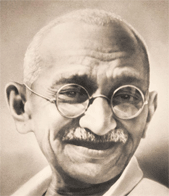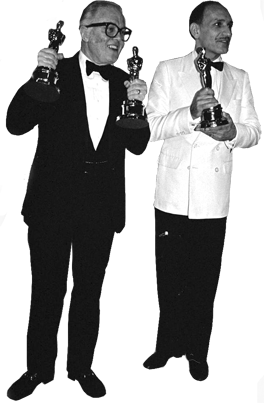 being modified in turn by his performance here.
being modified in turn by his performance here.Where's the rhetoric?
Gandhi stands and speaks. His tone influences the audience (measured, calm, convivial even towards the colonial representatives). His posture (upright) and gestures (deliberate, modest) influence the audience. His expression (smiling beatifically while he discusses the possibility of his own torture and death) influences his audience. His clothing (Western; later in his life, he switched to more traditional Indian clothes) influences his audience. His reputation (he was a lawyer) influences the reception of his words and gestures and clothing; and his reputation is being modified in turn by his performance here.
being modified in turn by his performance here.
But what is often missed in superficial views of rhetoric is that the words and phrases and evoked concepts are part of the persuasive matrix—not just in the way their rhythms and connotations and images build patterns of emotive energy, but the way the ideas they evoke build structures of intellectual force. The structure of the argument is a component of the rhetoric. Gandhi proceeds in a technical, quasi-legal manner. He explains the law, and then explicates it in a way that plays very directly on the cultural situation ("under this law, our wives and mothers are whores, and every man here is a bastard"). He defines terms ("I would not call them homes"). He spells out consequences ("They will have my dead body, not my obedience).
There is also rhetoric coming toward Gandhi, from members of the audience. Some of them stand up, shouting, to condemn the law, threaten violence, and pledge their lives. Gandhi has just incited them to this outrage, but he remains calm, resolute. He draws courage from the audience, shares their pledge to give their lives, but renounces their violence, and asks them to fight in a radical new way that he is partially manifesting before them with his tone and gestures and words.
There is another layer of rhetoric, too, of course, in the way the movie presents Gandhi and the audience and the speech. The screenplay, the acting, the camera placement, the editing, are all part of a persuasive matrix from Richard Atteborough, and from all the artistic and corporate  resources he marshaled, to influence generations of movie goers, in highly variegated ways. Where is the real Gandhi and his rhetoric in all this? Does any of it remain? What, for instance, is the suasive impact, the identificatory reach, of casting an Anglo to play an Indian, protesting against Anglo imperialism? Is it the ultimate act of colonial appropriation? Or is it the ultimate realisation of Ghandi's vision of pan-human equality?
resources he marshaled, to influence generations of movie goers, in highly variegated ways. Where is the real Gandhi and his rhetoric in all this? Does any of it remain? What, for instance, is the suasive impact, the identificatory reach, of casting an Anglo to play an Indian, protesting against Anglo imperialism? Is it the ultimate act of colonial appropriation? Or is it the ultimate realisation of Ghandi's vision of pan-human equality?
YouTube, by excerpting it, offers a different sort of persuasive matrix, compromised mightily by the size, the resolution, the ugly interface, and all the attendant distractions of computer use—it is a fragment competing with other fragments—but also enhanced mightily by the great distributional advantages of the web.
And what about me, your humble professor? What is my rhetorical agenda? I'm the one who stuck it in the 309C course page and now I'm presuming to tell you how to think about it. Am I encouraging your critical judgement by exposing you to the manifold inducing tentacles of symbolic life? Or am I homogenizing you with your 309C neighbors, channeling your thoughts and reducing your will. What do you think? What do you think I want you to think? Will this be on the test?
And you, even though you're under my (and Attenborough's, and Ghandi's) thumb (in highly variegated ways), you're there thinking about this suasive commingle—about the speech, about the movie, about your devious professor, weighing influences, balancing reasons, making judgments. You're applying rhetoric, to rhetoric.
So (and here comes the moral of the story) rhetoric is everywhere—technologically, culturally, and personally mediated. It’s not just in the classic arrangement of a man on a stage in front of an audience. It is in the currents of symbolic influence always swirling around us, burrowing into us, and emanating out of us. What are you going to do about it?